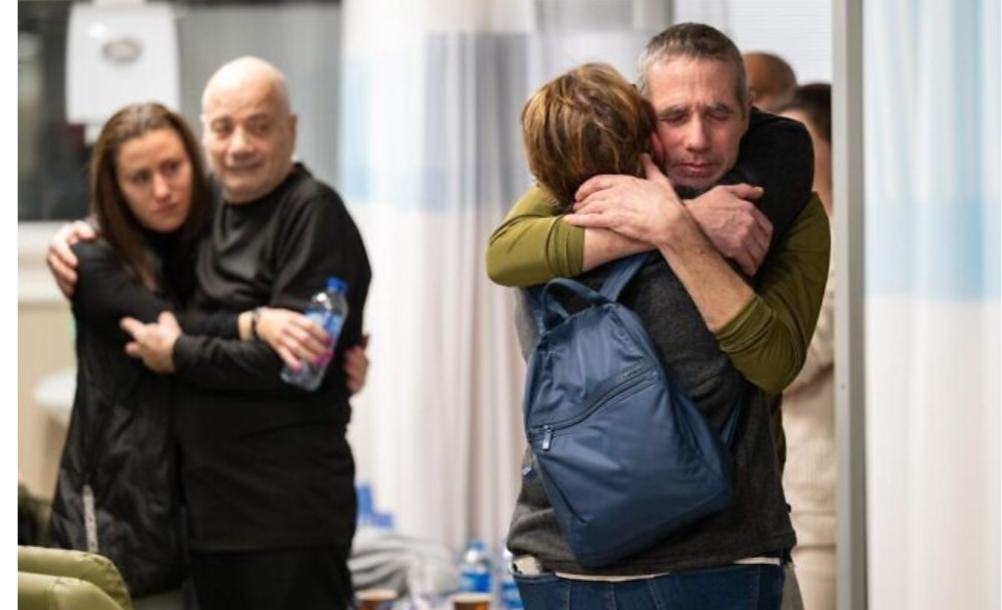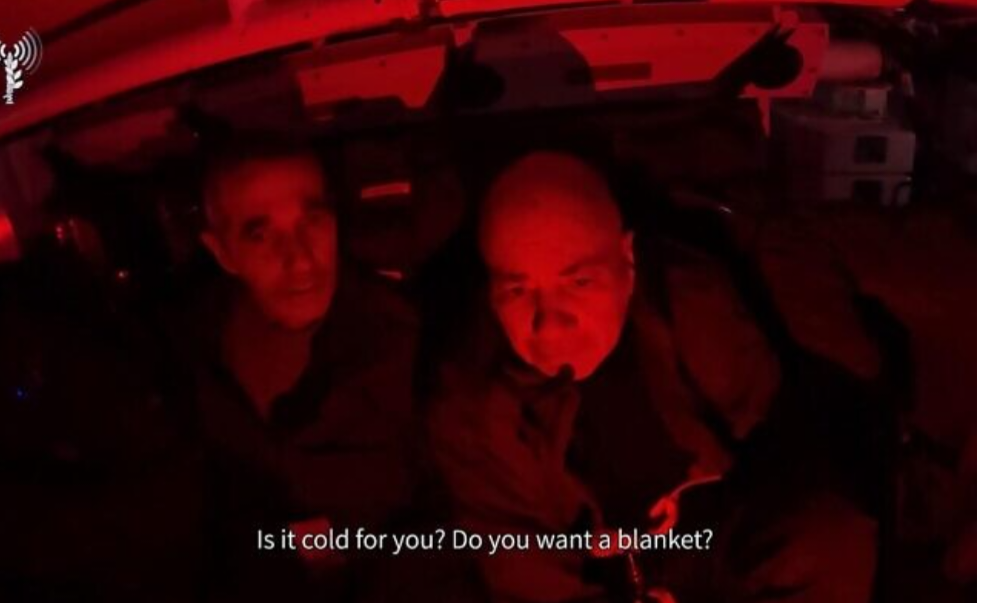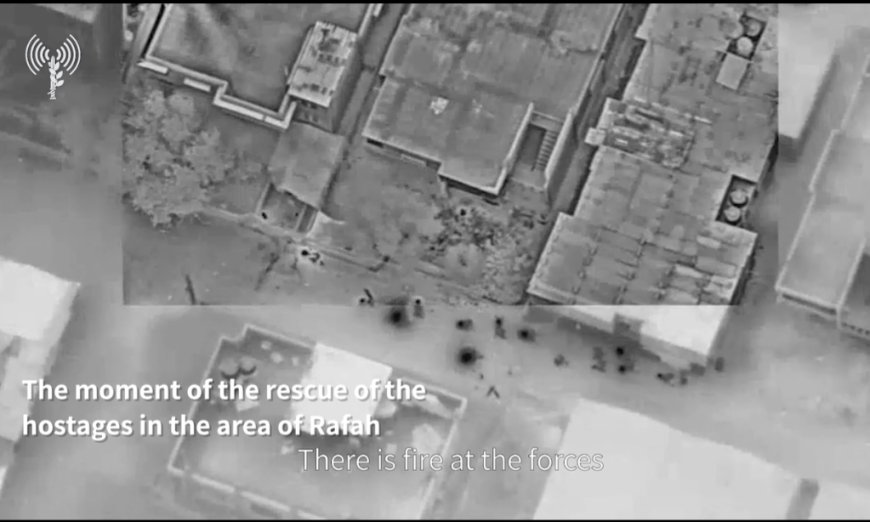Footage released Monday evening showed parts of the rescue of two Israeli hostages from a building in Gaza, though Israel’s defense minister cautioned that such daring extractions should not be counted on to free the 134 captives still held in the Strip.
The video, published by the Israel Defense Forces, showed special forces coming under fire in the southern Gaza city of Rafah, and the Navy’s Shayetet 13 commando unit accompanying Fernando Marman, 61, and Louis Har, 70, to a makeshift helipad to escape the Strip.
The long-planned rescue, only the second time that Israel has managed to successfully free captives by force since October 7, came as a rare bright spot after four months of war that has seen troops sweep through a devastated Gaza, but largely fail to bring the Hamas terror group to its knees, with pressure growing daily for an end to the fighting.
Marman and Har were both abducted from Kibbutz Nir Yitzhak on the morning of October 7, among 253 hostages kidnapped, as thousands of Hamas-led terrorists from Gaza stormed through southern Israel, massacring some 1,200 people and carrying out other atrocities against mostly civilian victims.
“The diamonds are in our hands,” a member of the special forces can be heard calling over the radio in the footage released Monday.
The call came at 1:50 a.m., approximately one minute after members of the Shin Bet security agency and police’s elite Yamam counterterrorism unit used explosives to breach a second-floor apartment where the pair were being held and killed three terrorists guarding them.

Louis Har (in black) and Fernando Marman reuniting with their loved ones, at Sheba Medical Center, February 12, 2024. (Israel Defense Forces.)
“The hostages are in our hands. There is gunfire against the force,” an officer can also be heard saying over the radio.
The Haaretz newspaper quoted a commander from the elite Yamam unit as saying that the two hostages were taken out of the building using ropes to avoid detection on the street outside.
He said that the men were shocked at first from the explosions used to breach the apartment where they were being held, but “recovered quickly” and tried to aid their rescue as much as they could.
They were hustled into armored vehicles to a makeshift helipad deep inside Gaza, then transferred to a military helicopter that brought them to Sheba Medical Center in Ramat Gan, wrapping up the entire operation within an hour.
Footage from one of the APCs shortly after the rescue showed Shayetet 13 commandos asking Marman and Har how they were.
“In shock,” one replied.
“Do you feel good?” an officer asked Har, who responded: “Excellent.”
The naval commandos gave the pair coats to wear before they headed out to the helipad. One of the soldiers also gave Har his own shoes, as Har was extracted barefoot, and can be seen tying the shoelaces for the former captive in the video.
The soldiers also offered water bottles to the pair and asked if they needed blankets for warmth, which they refused.

A screenshot from footage from February 12, 2024, from an APC showing Shayetet 13 commandos asking Fernando Marman and Louis Har about their wellbeing, shortly after they were rescued after being held by Hamas terrorists in the Gaza Strip since October 7. (Israel Defense Forces.)
The operation was drawn up weeks in advance, with various contingencies planned for, according to the army. During the actual operation, some adjustments were made based on the conditions on the ground.
Defense Minister Yoav Gallant called the rescue a “turning point in the campaign” against the Hamas terror group and promised that “there will be more operations” in a meeting with Yamam troops who took part in the raid.
“Hamas is vulnerable, Hamas is penetrable, and it is possible to go anywhere and do anything,” Gallant said.
But he also cautioned that Israel would need to negotiate for the rescue of most of the remaining hostages, with such rescues likely limited.
“We [still] have hostages and we need to reach them. Most of them we will not bring this way, [but rather] I hope, through processes of agreement. But how many more times will [a rescue operation] be required, and under what circumstances — who knows?” he added.
Prime Minister Benjamin Netanyahu called the foray “one of the most successful rescue operations in the history of the State of Israel,” in an appearance with the Yamam soldiers.
“You eliminated the kidnappers, the terrorists and made your way back to Israel unscathed – a perfectly executed operation,” Netanyahu told the troops, according to a statement from his office.
During the rescue, the air force carried out massive airstrikes in Rafah against Hamas terrorists to provide the special forces cover, the IDF said.
Hamas health authorities in Gaza claimed that 67 people were killed in the Israeli bombardment in Rafah, which is packed with Palestinians who have fled other parts of the Strip and now fear a looming operation in the southern Gazan city, which foreign officials say could create an even larger humanitarian disaster.
More than half of Gaza’s 2.3 million population is now crammed into Rafah, where hundreds of thousands live in sprawling tent camps and overcrowded UN shelters.
Mohamed Zoghroub, a Palestinian living in Rafah, said he saw a black jeep speeding through the town followed by clashes and heavy airstrikes.
“We found ourselves running with our children, from the airstrikes, in every direction,” he told the Associated Press.
White House National Security Council spokesman John Kirby said Monday the US was “pleased” to have learned about the rescue, while noting reports that dozens of Palestinian civilians were killed in IDF bombings during the operation.
“I can’t confirm those reports, but as we have said many times, the proper number of civilian casualties is zero,” Kirby said.
Netanyahu has said that sending ground troops into Rafah is essential to meeting Israel’s war goals. On Sunday, the White House said President Joe Biden warned Netanyahu that Israel should not conduct a military operation there without a “credible and executable” plan to protect civilians.
Biden’s remarks, made in a phone call with Netanyahu, were his most forceful language yet on the possible operation.
Discussion of the potential for a ceasefire agreement took up much of the call, a senior US administration official said. The official said that after weeks of diplomacy, a “framework” is now “pretty much” in place for a deal that could see the release of remaining hostages held by Hamas in exchange for Palestinian prisoners and a halt to fighting.
The official, who spoke on condition of anonymity to discuss negotiations, acknowledged that “gaps remain,” but declined to give details. The official said military pressure on Hamas in the southern city of Khan Younis in recent weeks helped bring the group closer to accepting a deal.
Kirby said that US President Joe Biden would continue working to secure the release of the remaining hostages.
It is believed that 134 hostages abducted by Hamas on October 7 remain in Gaza — not all of them alive — after 105 civilians were released from Hamas captivity during a weeklong truce in late November, and four hostages were released prior to that.
Three hostages — including Marman and Har — have been rescued alive by troops, and the bodies of 11 hostages have also been recovered, including three mistakenly killed by the military.
The IDF has confirmed the deaths of 29 of those still held by Hamas, citing new intelligence and findings obtained by troops operating in Gaza. One more person is listed as missing since October 7, and their fate is still unknown.
Hamas is also holding the bodies of fallen IDF soldiers Oron Shaul and Hadar Goldin since 2014, as well as two Israeli civilians, Avera Mengistu and Hisham al-Sayed, who are both thought to be alive after entering the Strip of their own accord in 2014 and 2015 respectively.
Agencies contributed to this report.

